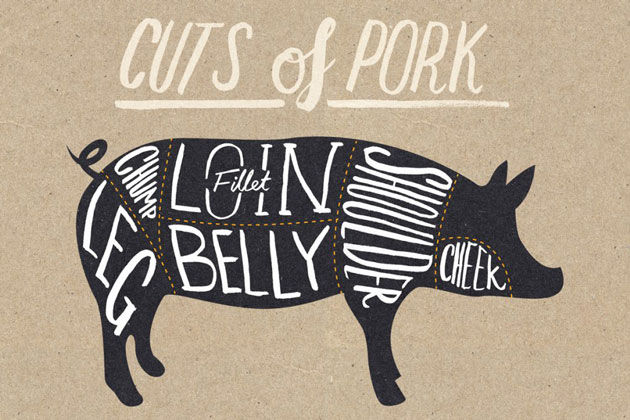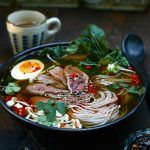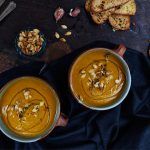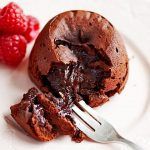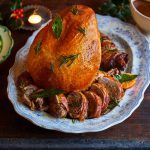Do you know your pork belly from your pork shoulder? What’s the difference between a rib chop and a loin chop? And what about the underrated cheek or liver? Knowing what pork cuts to choose can be super-confusing, so we’ve put together a guide with all the info you’ll need.
When buying pork, remember to always buy free-range or organic whenever possible. This means the animal has led a happy and healthy life, often born and reared outdoors in small numbers where it can forage and exercise as nature intended, rather than being kept in confinement. If you’re looking to trade up, look for higher-welfare certifications, such as RSPCA Approved or Certified Humane as a minimum. Pork is a great source of protein, vitamins and minerals, but just make sure you choose leaner cuts on most occasions, reserving the fattier pieces for weekend treats.

1. SHOULDER
The meat from the hard-working shoulder is a super-versatile cut. It can either be minced or diced for cooking slowly in stews, or kept on the bone and slow-roasted until tender and falling apart. The fillet from the top of the shoulder is just tender enough to be cut into steaks for grilling or barbecuing. As one of the most forgiving parts of the pig, it’s a great choice for a simple but impressive dinner party showstopper. The best way to cook a shoulder is slow and low – simply wrap it in a double layer of tin foil (to lock in the moisture) and pop it in the oven at 150ºC/300ºF/gas 2. Cook for 4 to 5 hours, or until you get melt-in-your-mouth, beautifully tender meat. If you’re cooking for a crowd, get on with your sides while it’s ticking away in the oven. Try this southern-style pork & slaw.
2. LOIN
Pork loin is a classic roasting joint, delicious as part of a traditional Sunday roast with apple sauce. The loin can either be cooked in one piece with the bone, or deboned, stuffed and rolled up to make a fantastically juicy roast, like this pork loin with a great herby stuffing or pear roasted pork loin joint. You can keep the skin on and crisp it up to get lovely crackling, or remove the skin and marinate the whole loin. For best results, be sure to rest the meat before carving. Chops that are cut from the loin are ideal for pan-roasting and grilling. If the fillet is left inside the pig when the chops are cut, you’ll get T-bone loin chops.
3. FILLET
The fillet or tenderloin is a long thin muscle, found on the inside of the ribcage and is a part of the loin cut. It can be cooked whole, cut into small round medallions and pan-fried, or cut into 1cm slices and bashed into thin escalopes. Pork fillet is the leanest of all cuts, so it’s the healthiest choice. Marinate or tenderise the fillet, then cook it quickly at a high temperature until slightly blushing pink in the middle for extra-juicy results. Cooking it for too long will dry the meat out – and always remember to rest the fillet after cooking to seal in the moisture.
4. RIB CHOP
Chops from the ribs are often grilled or barbecued, like this achiote recado pork. When a few chops are kept together in one piece they make a brilliant rib roast. Rib chops work particularly well with sage and apple as well as many spices – marinate your chops for extra flavour or try a dry rub. They are best cooked in a pan, on a grill or on the barbecue – use a high heat and turn the meat regularly so it builds up a beautiful gnarly crust and the fat renders down for juicy, succulent results.
5. CHUMP CHOP
A really meaty chop, cut from the rump of the pig, it can be bought either on or off the bone. Chump is a cheap cut with delicious flavour and texture. It’s versatile and easy to cook, either fried, grilled or barbecued. Serve with a tangy chutney or dressing to cut through the fattiness of the chop.
6. LEG
A leg is usually roasted whole, but it can also be boned and cut into smaller roasting joints, or thinly sliced to make steaks called escalopes. Pork legs are low in fat and can be quite dry when slow-roasted. Many are cured to make ham. Cooking the meat on the bone will help to keep it moist and produce lovely juices that you can use for gravy, like in this delicious roast pork leg recipe. Pork escalopes should be flash-fried or grilled quickly to prevent them from drying out. Try marinating or bashing the meat out with a rolling pin to tenderise it – Jamie’s chargrilled pork escalopes are well worth a try.
7. BELLY
A fatty, but incredibly tender cut of meat, the belly is delicious when slow-roasted. It’s also used to make streaky bacon. Pork belly is very high in fat, which makes it a delicious and versatile cut. It can be cooked slowly at a low temperature for soft meat that melts in the mouth, or it can be sliced and crisped up in a hot pan. It can also be roasted or stewed, but make sure you skim away some of the fat. As a robust cut, it works well paired with aromatic flavours and Asian spices. Try Jamie’s hot & smoky vindaloo with pork belly.
8. CHEEK
The cheek is a fatty, full-flavoured muscle with a great gelatinous texture, ideal for mincing or slow-cooking. Pork cheek is such an underrated cut and is really cheap to buy. Chop and cook it slowly in a stew or ragù, or keep whole and braise in a rich and sticky sauce.
9. LIVER
Pig’s liver is quite strong in flavour compared to lamb, calf and chicken livers, and is often used to make coarse country patés with plenty of garlic, black pepper and herbs. Italians use pig’s liver to add rich flavour to the base of stuffings or ragùs. Cook them quickly in a hot pan or gently braise them for a soft texture.
10. CRACKLING
Pork skin can be trimmed away from the flesh, salted and roasted to make crunchy pork scratchings, often served as a pub nibble. For fuss-free crackling, cook the skin separately from the meat. Doing it this way means you won’t need to worry about interrupting the meat while it’s cooking. Score the crackling to help distribute the heat – you can get your butcher to do this for you. You can also cut it up into long strips so they curl up as they cook. Cook the crackling on a flat baking tray in a very hot oven or under a hot grill with plenty of sea salt.
For more handy tips and tricks, check out this useful guide to roasting meat.
